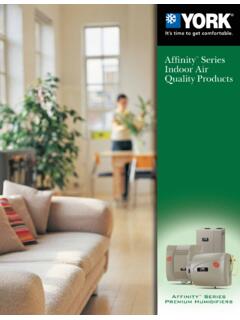Transcription of How Quickly Does Water Cool? - Stan Wagon
1 How Quickly does Water Cool? Stan Wagon Department of Mathematics and Computer Science Macalester College St. Paul, MN 55105. Robert Portmann 325 Broadway Boulder, CO 80305. 1. Newton's Law of Cooling Newton's Law of Cooling states that the rate of change of temperature of an object is proportional to temperature, the law is T t = -KHT - Tambient L, where T is temperature, t is time, and K is a the temperature difference between it and the surrounding medium; using Tambient for the ambient constant related to efficiency of heat transfer. Most mathematicians, when asked for the rule that governs the cooling of hot Water to room temperature, will say that Newton's Law applies and so the decline is a simple exponential decay.
2 Like many teachers of calculus and differential equations, the first author has gathered some data and tried to model it by this law. But it cannot be done: the data do not follow the simple exponential form that the law suggests. The correct model is quite a bit more complicated, and we do not give a definitive solution here, but show how one might try to model evaporation with the help of Mathematica's ability to fit parameters to the numerical solution of differential equations. 2. The Best-Fit Exponential Here is some data obtained by hand after pouring boiling Water into an aluminum pot. The first coordi- nates are the times in seconds; the second are degrees Fahrenheit.
3 Data = 880, 210<, 825, 204<, 834, 200<, 842, 198<, 854, 196<, 863, 194<, 880, 192<, 889, 190<, 8103, 188<, 8115, 186<, 8131, 184<, In[1]:=. 8145, 182<, 8158, 180<, 8175, 178<, 8195, 176<, 8213, 174<, 8225, 172<, 8250, 170<, 8274, 168<, 8298, 166<, 8315, 164<, 8335, 162<, 8353, 160<, 8387, 158<, 8411, 156<, 8440, 154<, 8475, 152<, 8492, 150<, 8520, 150<, 8530, 148<, 8550, 148<, 8560, 147<, 8570, 146<, 8585, 145<, 8600, 144<, 8610, 144<, 8620, 144<, 8630, 143<, 8640, 143<, 8647, 142<, 8660, 142<, 8670, 141<, 8680, 141<, 8690, 140<, 8700, 140<, 8710, <, 8720, 139<, 8730, 139<, 8740, 138<, 8750, 138<, 8760, 137<, 8770, 137<, 8778, 136<, 8790, 136<, 8800, 136<, 8810, 135<, 8820, 135<, 8830, 134<, 8840, 134<, 8850, 133<, 8860, 133<, 8870, 133<, 8880, <, 8890, 132<, 8900, 132<, 8910, 131<, 8920, 131<, 8930.
4 131<, 8940, 130<, 8950, 130<, 8960, <, 8970, 129<, 8980, 129<, 8990, <, 81000, 128<, 81010, 128<, 81020, 128<, 81030, <, 81040, 127<, 81050, 127<, 81060, 126<, 81070, 126<, 81080, 126<, 81090, <, 81100, 125<, 81110, 125<, 81120, <, 81130, 124<, 81140, 124<, 81150, <, 81160, 123<, , , , , , Mathematica in Education and Research Vol. 10 No. 3. 2 Stan Wagon and Robert Portmann 81170, 123<, 81180, <, 81190, 122<, 81200, 122<, 81210, 122<, 81220, <, 81230, 121<, 81240, 121<, 81250, 121<, 81260, <, 81270, <, 81280, 120<, 81300, 120<, 81340, 119<, 81356, 118<, 81380, 117<, 81418, 116<, 81725, 111<, 81740, <, 81825, 109<, 81890, 108<, 81955, 107<, 82022, 106<, 82077, 105<, 82160, 104<, 82244, 103<, 82320, 102<, 82408, 101<, 82473, 100<, 82613, 99<<.
5 We define the times and temperature, as well as the last time, the first temperature, and the ambient temperature, which was 79 . In[2]:= 8time, temp< = Transpose@ tmax = Last@timeD; temp0 = tempP1T; ambient = 79;. In[4]:= 200. 180. 160. 140. 120. 100. 0 500 1000 1500 2000 2500. Though it is easily done by hand, we use DSolve to solve the simple differential equation in Newton's Law. NewtonModel@K_D@t_D := Evaluate@Simplify@T@tD . T @tD -K HT@tD - ambientL, T@0D temp0 <, T@tD, tDP1T. In[5]:=. DD;. NewtonModel@ Out[6]= 79. + 131. -K t We now set up the residual corresponding to a value of the parameter K, which is a coefficient of heat conductance. In[7]:= residual@K_D := temp - NewtonModel@ A quick plot shows that the sum of squares attains a clear minimum.
6 In[8]:= Plot@residual@KD . residual@KD, 8K, 0, <D;. Mathematica in Education and Research Vol. 10 No. 3. How Quickly does Water Cool? 3. 600000. 500000. 400000. 300000. 200000. 100000. 0. 0 Now we wish to find the value of K so that the model is the best sum-of-squares estimate to the data. Note that K is not the true air- Water conduction coefficient, whose use would require knowing the shape of the pan and the amount of the Water , but is simply the value appropriate for this particular experiment. We can use FindMinimum, which requires a starting value and then finds a local mini- mum. FindMinimum should recognize the objective as being a sum of squares and use the Leven.
7 BergMarquardt method, which is especially robust for such problems. But it does not hurt to ask for that method explicitly. A seed of 0 works in this case, but in other modeling situations one may want a positive seed somewhere in the vicinity of the answer. 8K, 0<, Method "LevenbergMarquardt"D Timing In[9]:= FindMinimum@ @KD, Out[9]= Second, , 8K <<<. An alternative, somewhat faster, approach is to use FindFit, new in Mathematica version 5. It works better when we give a seed for the parameter k. In[10]:= Hfit = FindFit@data, NewtonModel@KD@tD, 88K, 0<<, tDL Timing Out[10]= Second, 8K <<. We define the best-fitting model. In[11]:= NewtonModelBest = NewtonModel @KD@tD.
8 Fit;. And we compare the model to the data. This best fit is horrible. Plot@NewtonModelBest, 8t, 0, tmax <, PlotStyle In[12]:=. Epilog Point data<, FrameLabel 8"Time HsecsL", " F."<, Axes False, GridLines 88<, 88ambient, 8<<<<, RotateLabel False, Frame True, PlotRange 88-100, 2700<, 870, 215<<, FrameTicks 880, 500, 2000, 2600<, 8temp0 , 100, 150, ambient<, None, None<D;. Mathematica in Education and Research Vol. 10 No. 3. 4 Stan Wagon and Robert Portmann 210. 150. F. 100. 79. Time HsecsL. 0 500 2000 2600. It is evident that the temperatures do not follow a rule as simple as Newton's Law. Yet it appears equally evident from the data that there is some sort of pattern in the decreasing temperatures.
9 Exercise. Use Newton's Law to fit various subsets of the data, such as the first 50 points, the last 50, or the middle 50 (making sure to change the initial temperature appropriately). The diagram below shows the best fit when the last 57 points are used. Such experiments show how difficult interpretation can be. The fits are generally good. does that support the view that Newton's Law is a good model when the temperature does not vary too much and the difference between the initial and ambient temperatures is not too great? Or is the fit better only because the smaller data sets are more nearly linear? 150. F. 132. 100. 79. Time HsecsL. 0 500 2000 2600. 3. An Oily Solution It turns out that the heat loss from hot Water due to evaporation is considerable; this effect is com- pletely ignored by Newton's Law.
10 Before going into the details of evaporation, we show what happens when a thin sheet of oil is placed over the Water . This cuts out almost all of the evaporation. Macalester College student Tak Iwanaga used some physics software (LoggerPro ) to obtain data in this case. His ambient temperature was 68 and he tracked the temperature every 6 seconds for one hour. Here we useevery 10th point only since that is more than enough to get the fit. Mathematica in Education and Research Vol. 10 No. 3. How Quickly does Water Cool? 5. dataOil = 886., 188<, 866., <, 8126., 185.<, 8186., <, 8246., <, 8306., <, 8366., <, 8426., <, 8486., <, 8546., <, 8606., <, 8666., 167.<, 8726., <, 8786.






